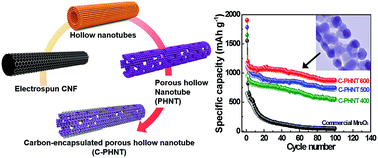Hierarchical architecture of hybrid carbon-encapsulated hollow manganese oxide nanotubes with a porous-wall structure for high-performance electrochemical energy storage†
Abstract
Metal-oxide-based anode materials in energy storage devices continue to be of considerable interest for both fundamental science and potential technological applications because of their diverse functionalities, high theoretical capacity, cost-effectiveness, and non-polluting nature. However, despite these favourable features for various power source applications, important challenges associated with insertion-induced structural degradation remain, leading to capacity fading, and must be addressed to move towards the practical use of high-capacity metal oxide anodes. Here, we report the successful synthesis of novel hierarchical carbon-encapsulated manganese oxide architectures with hollow-tube structures and unique porous walls via a simple microwave process coupled with a hydrothermal method. This approach provides beneficial synergistic effects in terms of structural stability, electrochemical active surface areas, and electrical and ionic pathways. The carbon-encapsulated porous hollow manganese oxide nanotubes exhibit excellent electrochemical characteristics with large reversible specific capacity and excellent cycling stability (875 mA h g−1 capacity retention up to 100 cycles) as well as outstanding high-rate performance (729 mA h g−1 at 700 mA g−1), which is the highest value thus far reported for manganese-oxide-based anode materials.


 Please wait while we load your content...
Please wait while we load your content...